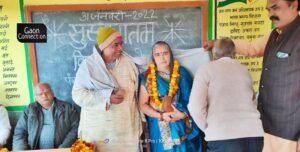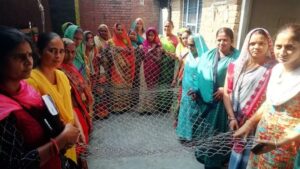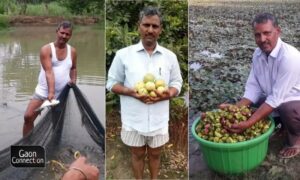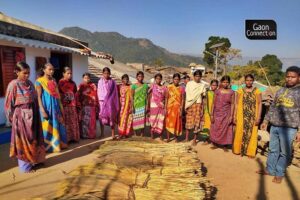Sitapur, Uttar Pradesh
With the COVID19 pandemic resulting in lowering of incomes for the cultivators, and the small and marginal farmers being the worst hit, the Sitapur district’s agriculture department has devised an integrated farming model that can be adopted on an acre (0.4 hectare) of land and can help farmers with small landholdings earn on an average Rs 20,000-Rs 25,000 per month.
Arvind Mohan Mishra, deputy director of agriculture department, Sitapur, told Gaon Connection that the integrated farming model combines fish farming, poultry farming, and vegetable cultivation with the primary crop of sugarcane. It can be easily implemented on an acre of land, and a live model of this integrated technique has been set up at the office of the district agriculture department, about 88 kms from the state capital Lucknow.
“The COVID situation has resulted in financial difficulties for people in the rural areas. We have come up with the project so as to help the farmers become self-reliant,” Mishra told Gaon Connection. “The total cost of setting up an integrated farm is pegged at around 78,000 rupees. A small pond is also created in which ducks and fishes are reared,” he added.
The integrated farming technique is especially beneficial to the small and marginal farmers, which, according to a report by Food and Agriculture Organization (FAO), comprise 82 per cent of the total farmers in India.
Integrated farming with poultry and pisciculture
As per the model developed by the Sitapur’s Agriculture Department, 35 per cent of the farmers’ land holding is to be occupied by fish rearing and poultry (including ducks), whereas 20 per cent of the land will be used for cultivating a cash crop like sugarcane. Another 25 per cent of the land is to be used for growing a staple crop like paddy, 10 per cent for building pathways to access these crops, and the remaining land is used for growing vegetables.
“The integrated farming system ensures that the use of chemical fertilisers is minimum and organic farming techniques are widely employed. For example, the excreta from the poultry is not only good for soil fertility but is also used as a feed for the fishes in the pond. Also, we use earthworms to make vermicompost which is further used to enhance soil fertility,” Mishra told Gaon Connection.
Input cost for integrated farming
The majority of the input cost for integrated farming, which is pegged at a total of Rs 108,000, will be shared by the Department of Fisheries and the Agriculture Department by 40 per cent and 50 per cent respectively.
The input cost for fishes would be around Rs 5,000 and the poultry will cost around Rs 14,000, informed the deputy director. The Kadaknath variety of poultry is advised in the integrated farming method and it grows to weigh around 1.5 kilogrammes (kgs) to two kgs in a span of four months. This can easily fetch the farmers a profit of around Rs 142,500.
“Also, fishes grow really fast. They grow in 25 days and it can add another forty thousand rupees to the farmers’ income. The sugarcane and mustard that is planted together can reap profits worth Rs 45,000 with an input cost of fifteen thousand rupees,” the official told Gaon Connection.
Training the farmers
The district agriculture department has already started training the farmers in integrated farming. According to Mishra, at present 10 farmers are being trained to use this technique in their fields and a letter has been written to the higher authorities to implement integrated farming across the state.
Anand Kumar, a 55-year-old farmer from the Bambora village in the district’s Aliya block is one of the farmers who has received the training at the Krishi Vigyan Kendra (farm science centre) in Sitapur.
“I am excited about what I have learnt at the centre and I am about to implement it on an acre of my land. The technique seems promising and I think it will raise our incomes,” Kumar told Gaon Connection.



















